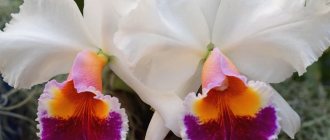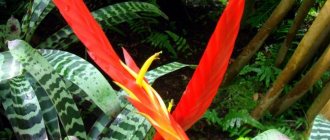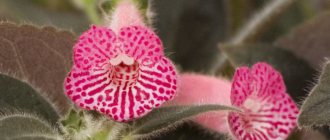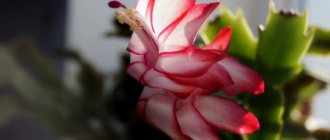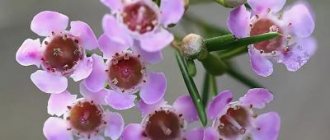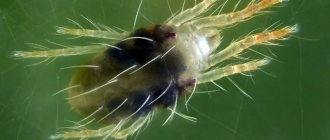When grown indoors, the shrub usually grows no more than 1 meter in height. Its numerous shoots are highly branched and are covered with oppositely located large leathery leaves of a juicy green hue.
The plant can bloom in comfortable conditions all year round. Its inflorescences combine up to 20 medium-sized flowers with smooth or corrugated petals of a snow-white or cream shade; many varieties have a subtle, very pleasant aroma.
See also how to grow indoor plumeria and dipladenia.
| High growth rate. |
| Blooms throughout the year. |
| The plant is easy to grow. |
| Perennial. |
Tabernemontana: care at home. Briefly
| Temperature | In the warm season +22-+25°С, in the cold season – about +15°С. |
| Air humidity | Increased, at temperatures above +20°C, requires additional spraying at least 2-3 times a week. |
| Lighting | Bright, diffused with a moderate amount of direct sun in the morning and shading in the afternoon. |
| Watering | In summer, the flower is watered generously 1-2 times a week, in winter - moderately 1 time a week. |
| Soil for tabernemontana | An industrial substrate with high acidity or a soil mixture of leaf, turf and coniferous soil with the addition of peat and sand (all components in equal parts). |
| Feeding and fertilizer | During the active growing season, apply liquid fertilizer with predominant potassium and phosphorus 2-3 times a month. |
| Transplanting Tabernemontana | As needed: when the old pot becomes small or the soil completely loses its nutritional value. |
| Reproduction | Semi-lignified cuttings and seeds. |
| Features of cultivation | Tabernemontana does not tolerate drafts and temperature changes at home. Healthy plants do not need pruning, but it is useful to periodically pinch the tops for more luxuriant tillering. |
What is a plant
Areca palm chrysalidocarpus - home care
Tabernemontana is a plant native to Central and South America.
The flowers are white and beige, they are double and pleasant to the touch. There are quite a lot of types.
Tabernemontana is a very unpretentious, evergreen indoor plant, so it quickly finds owners.
An interesting feature of the flower is that the aroma increases with the onset of dusk and darkness.
Home care
1. The temperature in the room where Tabernemontana grows should be moderate. The plant should not be overcooled, as this may affect flowering.
2
The plant requires good lighting, which is very important to consider. On hot summer days, you need to shade the plant so that the sun does not burn the leaves.
3. Tabernemontana needs to be watered moderately, avoiding even short-term drought in the soil. When it dries about halfway, then you need to water it again.
Water for irrigation must either be filtered or allowed to sit for a day. It should also be cool, but not cold. In summer, the plant needs to be watered more often, in winter, much less often.
4
Air humidity should be increased, which is very important. You also need to give the plant a warm shower, or wipe the leaves with a damp sponge.
If the air in the room is too dry, then the plant must be sprayed, but only with settled water. The water should be allowed to sit for a day.
5. The plant needs to be pruned to give it a beautiful shape.
6. Tabernemontana needs to be fed with complex fertilizers, approximately once every two weeks. This will be enough and she will grow well.
7. Various pests can settle on the plant: aphids, scale insects, whiteflies and others. Onion or garlic decoctions will save the plant from them.
8. If the leaves are yellow and limp, then the reason is a lack of watering.
If the color of the plant begins to fade, the reason is not enough light.
If buds that have not yet bloomed begin to fall off, the reason is too high a temperature or low air humidity.
If the leaves fall, do not worry, as the plant gets rid of the old ones. On the back of the leaves you can see small white drops, which then begin to turn yellow.
This process is not related to diseases, so there is no need to worry. This is the release of a substance from the leaves that appears as a result of heavy watering and a sharp change in air temperature. At the same time, this process does not harm the plant at all.
Signs and superstitions
1. Positive action.
If a plant grows in the house of an unmarried girl, then most likely she will find love. If in the house of a married woman, then it will protect her from adultery.
The plant absorbs negative energy, giving out positive energy. It charges people with positivity and can bring harmony and mutual understanding to the family.
2. Negative action.
The plant can bring trouble to the family. It can also cause a rift between loved ones and destroy a family. The owners of the house may be haunted by failures in their personal lives or financial well-being.
Tabernemontana will decorate your home and become an exclusive element of interior decor.
Flower starting with "T", 14 letters.
Caring for Tabernemontana at home. Details
Tabernemontana flowering
A tabernemontana plant at home, with proper care, can bloom continuously throughout the year. Inflorescences appear on the tops of young shoots and consist of 3-20 snow-white or cream flowers with smooth or double petals (depending on the variety). The flowers of most varieties have a pleasant aroma similar to jasmine.
What to do to make tabernemontana bloom in winter
In order to enjoy the lush flowering of tabernemontana in winter, it should be cared for as usual throughout the year. Water the plant abundantly, but moderately, maintain the air temperature in the room at +22°C, and fertilize every 2 weeks.
If necessary, additional illumination of the bushes with artificial light sources will be required.
Temperature
During the period of active growth, domestic tabernemontana feels most comfortable at an air temperature of about +22°C, but in winter the plant needs to be kept in cooler conditions, lowering the temperature to +15°C.
Spraying
High humidity is important for tabernemontana, especially if the air temperature in the room where it grows is above +20°C. The plant favors regular spraying of the foliage with warm, settled water. The procedure is carried out every 2-3 days, taking care to protect the flowers and buds from moisture.
Lighting
The plant needs a lot of light for active growth and abundant flowering, but exposure to direct sunlight on the crown is permissible only in the morning and evening. It is best to place a pot of tabernemontana on an eastern or western windowsill.
A flower placed on a south window should be shaded during hot midday hours.
Watering
In the warm season, water the plant generously 1-2 times a week, but between waterings allow the soil to dry out to about half its depth. Water for irrigation is taken at room temperature, always clean and settled. In winter, the plant is watered less frequently, so that moisture does not stagnate in the soil at the roots.
Pot for tabernemontana
Select a container for the plant that is deep and wide with a drain hole to remove excess moisture. The pot should be such that, if necessary, you can easily shake out the roots of the flower along with the earthen lump. Ball-shaped containers with recesses and recesses on the inner surface are not worth buying for tabernemontana.
Soil for tabernemontana
The substrate for tabernemontana should be breathable and slightly acidified. You can purchase a suitable mixture at a flower shop or prepare it yourself by mixing leaf, turf and coniferous soil with peat and coarse sand in equal proportions.
Feeding and fertilizer
Caring for tabernemontana at home includes regular feeding with liquid phosphorus-potassium fertilizers that do not contain lime. Procedures are carried out 2-3 times a month during the entire active growing season.
Transfer
Tabernemontana has a rather fragile root system, so it does not tolerate any manipulation particularly well.
The plant is replanted as needed, no more than once every 2-3 years, when the pot becomes small or the soil completely loses its nutritional properties. Tabernemontana is transplanted using the transshipment method without destroying the earthen clod.
Pruning tabernemontana
Tabernemontana forms a beautiful crown at home on its own without additional pruning. Only those plants that, as a result of improper care, stretch or twist their shoots, have an untidy shape and grow “crookedly” need to be trimmed.
Rest period
Tabernemontans rest during the winter months, when it is not possible to provide them with adequate conditions for active growth and flowering. During the dormant period, the plant is transferred to a cool room with an air temperature of about +15°C, watering is reduced, and fertilizing is temporarily canceled completely.
Description of the flower
Tabernemontana flowers are tubular in shape, about 4 cm in diameter, with five waxy white pin-shaped petals. Planted singly or in small groups in the garden or at home, they bloom from spring to autumn.
Although they have a sweet aroma, they should be enjoyed in the evening as the aroma quickly dissipates on a hot day. They show their beauty best at night, especially on moonlit nights, due to the waxy petals that give the flowers a mysterious glow.
The fruits are rare, but with proper plant care, curved, ribbed, cylindrical seed pods up to 7 cm long can appear. They grow in pairs and have three to six small seeds inside, encased in fleshy orange or bright red flesh.
Propagation of Tabernemontana by cuttings
Planting material is cut from semi-lignified shoots of the mother plant. The cuttings should be about 10 cm long and have 2-3 pairs of unfolded leaves. Rooting can be carried out in water or a peat-sand mixture; to speed up the process, the sections are pre-treated with a root formation stimulator.
Roots form slowly, so full rooting can take up to 2 months. If the seedling begins to grow, it can be transplanted into an individual pot; in favorable conditions, it will be able to bloom within a year.
Benefit for health
The wood is aromatic and spicy, and is sometimes burned as an incense substitute in some parts of its natural habitat.
In traditional Indian or Ayurvedic medicine, the juice from the flower buds is mixed with oil and applied to the skin to treat inflammation and externally to the eyes as a treatment for ophthalmia or eye inflammation.
Diseases and pests
Exotic tabernemontana has a rather capricious character. It does not make impossible demands on indoor growing conditions, but it reacts to errors in care with negative changes in appearance.
- Tabernemontana leaves turn yellow (chlorosis) due to unsuitable soil or watering with too cold, hard water. The plant needs to be transplanted into the correct substrate and the watering regime must be adjusted.
- Tabernemontana leaves wilt and turn yellow in soil that is too acidic or when root rot occurs. An urgent inspection of the root system, removing its damaged areas and replanting it in the correct substrate will help save the flower from death.
- Shoots stretch out if the lighting of the plant is poorly organized. In this case, the tabernemontana needs to be moved to a brighter place.
- Tabernemontana buds fall off without blooming if the room is too hot and the air humidity is low. The room should be regularly ventilated (but protect the flower from drafts), and the plant should be sprayed with warm, clean water.
- Tabernemontana leaves fall off during the process of plant renewal. This is a completely natural process, and not a sign of illness or an error in care.
- Tabernemontana leaves split when not watered enough or lack nutrients. The plant needs to organize an optimal regime of watering and fertilizing.
- White droplets appear on the underside of the leaves when there is excessive soil moisture or after a sharp temperature change. It is also possible that these are traces of flower parasites. The flower is examined, treated with an insecticide if necessary, and comfortable conditions for growth are provided.
- The flower grows poorly, the leaves turn yellow, buds do not form - most likely the roots are cramped in the pot and need to be transplanted into a larger container.
- The edges of the leaves darken and dry out when there is low humidity and irregular watering. Regulating these components of care helps solve the problem.
- Dark spots on the petals may be the result of overwatering. The soil in the pot should be slightly dried between waterings.
- Holes in the leaves appear due to irregular watering. Even short-term drying of the soil should not be allowed, as this will quickly cause the plant to lose its decorative properties.
Scale insects, aphids, mealybugs and spider mites are dangerous for tabernemontana. When they appear, the plants are immediately treated with special insecticidal preparations.
Interesting Facts
Listed as "escape" from cultivation in at least a few reference publications, it is unlikely to become a serious weed due to its poor fruiting and seeding abilities.
When broken, the stem releases toxic milky latex. However, in prescribed quantities, parts of the plant are used to treat a wide variety of ailments. The root is used to treat hypertension, headaches, scabies and toothache. The roots, leaves and flowers are used to treat snake and scorpion poisoning.
Non-medicinal uses include using the wood as incense and perfume, or using the pulp around the seeds to make red dyes. If used incorrectly, all parts of the plant are poisonous.
The roots in particular are believed to contain poison, but its effects on people and pets are unknown.
In India, the bark of the root and stem of this species is used in folk medicine to treat wounds, as well as snake bites and centipede bites. The bark is also considered a medicine in India that can cause delirium, that is, have a psychoactive effect.
In Sri Lanka it is considered a "forbidden fruit" and is included in the same folk taxonomic category and is described as a poisonous plant. Muslims call this fruit “the forbidden fruit of the Garden of Eden,” and Europeans living in Sri Lanka call it “Eve’s apple.” The seeds are said to have strong narcotic and hallucinogenic effects.
Adapting to different soil and humidity levels, the plant is distinguished by its beauty and elegance of flowers. It is easy to grow and keep indoors.
Types of Tabernemontana domestica with photos and names
Tabernemontana divaricata (lat. Tabernaemontana divaricata)
The most popular variety in indoor floriculture with densely branching shoots and large leathery leaves of a dark green hue. The inflorescences are very lush, combining up to 20 pieces. snow-white flowers with ruffled petals and a delicate jasmine aroma.
Elegant Tabernaemontana or elegans (Tabernaemontana elegans)
An unpretentious variety with narrow elongated leaves of a juicy green hue. The flowers are large, non-double, white or cream-colored, collected in umbellate inflorescences of 3-10 pieces. Their aroma is very weak, unlike other varieties.
Tabernemontana crowned (lat. Tabernaemontana coronaria)
Compact, highly branched shrub with raised, oval-shaped leaves of a dark green hue. Umbrella inflorescences appear on the tops of shoots and unite up to 15 medium-sized flowers with single petals of pure white color with a pronounced aroma.
Tabernemontana Holst (lat. Tabernaemontana holstii)
A rare variety with elongated oval-shaped leaves of a juicy green color. The flowers are snow-white, quite large, with an unusual shape of petals - long and curved, similar to propeller blades.
Tabernaemontana sananho (lat. Tabernaemontana sananho)
A spectacular plant with large, very dense leaves of a rich green hue and unusual flowers, the thin snow-white petals of which are intricately twisted along the entire length.
Plant characteristics
Tabernemontana belongs to the Kutrov family. It got its name in honor of the German scientist who first described the plant. His name was Jacob Tabernemontanus. He was the "father" of German botany. During his life he described a large number of plants. Tabernemontana is found in subtropical and tropical zones:
- Africa;
- South-East Asia;
- America.
It grows in height up to one and a half meters. The stem is strong and woody. The leaves are leathery with a glossy sheen and distinct veins. With pointed ends and oblong shape. The maximum leaf length is 25 cm. Inflorescences can include up to 20 buds. Flowers reaching 6 cm in diameter can be:
- white;
- creamy;
- terry;
- simple.
Under favorable circumstances, an ovary forms after the flowers. Over time, it grows into a fruit with seeds. The bush blooms almost all year round. The peak occurs in spring and summer. Botanists identify almost 100 species of this plant, but only some varieties are popular among gardeners.
Tabernemontana divaricata has a spherical crown with large leaves and white inflorescences. The aroma of flowers intensifies in the dark. The fruits are dark green.
1.Seven secrets of success:
| 1. Growing temperature: in spring and summer it is quite warm at a temperature of 18 to 24 ° C, in winter a cool dormant period is desirable at a temperature of 5 - 10 ° C. |
| 2. Lighting: light shading from direct rays of the sun in spring and summer, maximum light in autumn and winter. |
| 3. Watering and air humidity: during the growth period, watering is abundant and regular with drying of the top layer of soil between them; in the winter months the frequency of watering is greatly reduced. Air humidity increases when the air temperature rises above 24° C. |
| 4. Pruning: easily tolerates formative pruning, which is carried out after flowering; remove old and diseased branches in a timely manner. |
| 5. Soil: nutritious, loose, well-drained, with a slightly acidic pH. |
| 6. Feeding: in spring and summer, when tabernemontana is growing, we feed it monthly; in winter we do not feed it. If kept warm, the frequency of fertilizing in the winter months can be reduced to once a month. |
| 7. Reproduction: by stem cuttings or sowing seeds. |
Botanical name: Tabernaemontana.
Tabernemontana flower - family
Origin. Tropical regions of Asia.
Description. The genus "tabernemontana" or Indian carnation consists of approximately 120 plant species that are perennial evergreen shrubs with a rounded crown. The stems branch abundantly, young shoots are green, but with age they become lignified and covered with light brown bark. When damaged, the stems release a milky sap. The leaves are large, glossy, dark green, oblong-oval, up to 15 cm long, located opposite. The flowers are single, white with 5 rounded petals, up to 5 cm in diameter. Modern varieties have corrugated edges of the petals and fragrant flowers. In its appearance, tabernemontana resembles jasmine.
Height. This shrub grows slowly and reaches a height of 1 - 2 m, but it is easy to regulate by pruning.
Transfer
Before you start planting a plant in a pot, you need to prepare everything you need. The soil required is light, loose, and can easily pass water. Acidity should be between 4.5-5.5. If you make the soil mixture yourself, then take equal parts of coniferous and deciduous soil, river sand, peat and humus. In the process of caring for a flower, add a little lemon juice to the soil once a month.
The choice of pot is of great importance. It is best if it is deep and wide enough. Under no circumstances should you take a product that is spherical or narrowed in the middle. Drainage must be placed at the bottom of the pot to protect the root system from waterlogging.
Tabernemontana needs to be replanted frequently, as the bush grows quickly
Optimal place
In order for tabernemontana to bloom and develop, you need to choose the right place where the pot will stand. Since the plant is completely undemanding, it can be placed on or near a windowsill. The length of daylight hours does not play a special role for the development of the flower. Five to six hours of daylight is enough for the flowers to bloom and smell fragrant.
If the sun illuminates it as long as possible, then the flowering will be more abundant. Therefore, it is best to place the tabernemontana on a window on the east or west side. If the flower is on the south side, then at noon it is recommended to cover it from direct sunlight.
The plant requires two or three repottings per year because it grows and develops quickly. In the process, you need to take into account that the root system, although powerful, is quite fragile. Therefore, it is recommended to transfer it from pot to pot along with a lump of earth. The new pot must be slightly larger than the previous one and filled a quarter with new drainage. The procedure should proceed as follows:
- the plant is removed from the old vessel along with the soil, which cannot be shaken off;
- the bush is placed in a new pot for drainage;
- the root system is covered with fertile soil;
- the plant is lightly watered after transplantation;
- If necessary, you need to add soil.
We invite you to familiarize yourself with the Horse: racehorses - riding breeds
Replanting is carried out 2-3 times a year while it is still young, but a flowering bush only once every 3 years. The most suitable soil mixture is a loose and permeable substrate. It consists in equal shares of:
- humus;
- peat;
- perlite;
- sand.
Popular articles Thuja foldata Zebrina, regular and Extra Gold, description of the variety, planting and care
It is worth laying a good drainage layer at the bottom of the container. Slightly acidic or slightly alkaline fertile soil is ideal as a base for planting tabernemontana.
Conclusion
Tabernemontana is an ideal exotic indoor shrub for those who want to have a beautiful plant that blooms all year round in their home with a minimum of time and effort.
About the beautiful and fragrant Tabernemontana flower, watch the following video:
Flowering evergreen tabernemontana
(Tabernaemontana) belongs to the cucumber family (Apocynaceae). It is native to the subtropical and tropical regions of Africa, America and Southeast Asia. This shrub prefers to grow in coastal areas.
This plant was given such a very difficult name by the German J. T. von Bergzabern, who was a botanist and physicist and lived in the 16th century. He called him by his name, which he translated into Latin. If we literally translate this name into Russian, it will sound like “mountain monastery” or “mountain tavern”.
When grown at home, such a shrub can reach 150 centimeters in height. Green, leathery, shiny, pointed leaves have an oblong shape. The length of the leaf plate can vary from 7 to 20 centimeters (depending on the type), and the width - from 3 to 5 centimeters. Terry fragrant flowers can reach 4 centimeters in diameter. They can be painted white or cream. Flowering lasts all year round.
This plant is often confused with. The fact is that their foliage is similar in appearance. However, these plants can be easily distinguished from each other during the flowering period. So, in tabernemontana they look similar to small roses, and in gardenia they look like bells, and their petals are corrugated.
Illumination
Bright lighting is necessary, but it must be diffused. It is recommended to place it on east or west windows.
Temperature
Loves warmth. The most suitable temperature for keeping such a plant is from 18 to 25 degrees. In the summer, it is recommended to take it outside if possible (to the garden, to the balcony). In winter, the air temperature in the room where this tree is located should not fall below 15 degrees. Does not tolerate drafts.
Humidity
High humidity is necessary, but tabernemontana can also adapt to the dry air of city apartments, but in any case it is necessary to systematically moisten the foliage with a sprayer. For this, well-settled water is used. You should also remember that it is better to spray this plant more often than to water it.
Features of transplantation
While the plant is young, it must be replanted frequently (up to several times a year). An adult specimen is subjected to this procedure once every 2 or 3 years. A suitable substrate must be loose and permeable. To prepare the soil mixture, combine humus and leaf soil, peat, perlite and sand, which should be taken in equal proportions. Don't forget to make a good drainage layer at the bottom of the container. Both slightly acidic and slightly alkaline soil are suitable for planting.
Reproduction methods
This plant can be propagated at any time. Trim the apical cutting, which should be semi-lignified and its length should be from 8 to 10 centimeters. Rinse the cut under running lukewarm water to remove the milky juice, as it clogs the vessels of the tabernemontana. To make roots appear faster, treat with a product that stimulates their growth (Heteroauxin, Kornevin). Planting is done in a small container, and the cutting should be covered with a plastic bag or glass jar on top. Place in a warm place (about 22 degrees) and do not forget to ventilate systematically. Rooting will occur in about 4 weeks or later. When the roots no longer fit in the pot, the plant needs to be transferred to a larger container. The development of such a plant is relatively rapid, and flowering can begin some time after the roots appear.
Pests and diseases
Most often it suffers from chlorosis. To avoid this, treatments with iron sulfate or iron chelate are needed, and it is also necessary to acidify the substrate and add trace elements.
It can settle on a tree either.
It happens that small whitish droplets form on the reverse surface, which dry out over time and become yellowish. This is a natural process of secretion of substances from leaf glands. They can form as a result of waterlogging of the soil or a sharp change in temperature. They do not harm the tree.
If the room is too hot and the humidity is low, the buds may stick together and die without opening.
